- Electric vehicle production poses health and safety risks due to micro-fine dust from lithium-ion battery manufacturing.
- Invisible particles, such as lithium, cobalt, and graphite, can cause respiratory issues and potentially lead to fires and explosions.
- Camfil Air Pollution Control (APC) emphasizes the urgent need for effective dust collection systems in battery factories.
- Implementing these systems is crucial for protecting worker health and maintaining safe operations.
- Proactive dust management is essential to prevent costly disruptions and enhance operational efficiency.
- The electric vehicle industry’s growth should prioritize both sustainable practices and worker safety.
- Clean energy production must safeguard the well-being of workers, ensuring a comprehensive approach to sustainability.
A silent menace lurks in the sleek, futuristic factories producing electric vehicles, threatening both the health of workers and the safety of operations. As these facilities manufacture the lithium-ion batteries that power modern electric cars, they unleash a potentially dangerous foe: micro-fine dust made up of elements like lithium, cobalt, nickel, manganese, and graphite. While the gleaming exteriors of electric vehicles symbolize the future, it is the invisible particles within their production sites that raise immediate concern.
As the demand for electric vehicles soars, the industrial processes involved in their creation inadvertently release a toxic cocktail of dust. These microscopic particles, while invisible to the naked eye, possess the capacity to cause significant harm. Workers who inhale this toxic mix risk respiratory ailments and, with prolonged exposure, long-term health issues. Meanwhile, this fine dust—capable of accumulating prodigiously—carries with it the potential for catastrophic fires and explosions.
Camfil Air Pollution Control (APC), a leader in industrial dust and fume management, raises an alarm about these often-overlooked hazards. By illuminating the risks posed by dust in electric vehicle battery manufacturing, Camfil APC stresses the critical importance of implementing robust dust collection systems—a move that goes beyond merely meeting regulatory standards. For those steering the helm at such facilities, safeguarding the health of employees and ensuring the seamless operation of their plants must take precedence.
The traditional view of dust as a benign, inevitable byproduct of industrial work is swiftly becoming outdated. Instead, companies like Camfil APC advocate for proactive measures that contain and eliminate threats at the source. These tailored solutions not only mitigate health risks but also prevent costly interruptions and potential disasters, fundamentally transforming operational efficiency.
As the world races towards sustainable solutions and attempts to mitigate climate change, the journey should not sacrifice the safety and well-being of those on the frontlines of innovation. The rise of electric vehicles should herald a future free not just of tailpipe emissions but also of harmful production processes—a future where clean energy does not come at the expense of those who create it.
The Hidden Dangers of Electric Vehicle Production: What You Need to Know
Understanding the Risks of Dust in EV Manufacturing
The electric vehicle (EV) industry is on a meteoric rise as the demand for cleaner transportation solutions intensifies. However, behind the scenes, the manufacturing facilities producing the lithium-ion batteries that power these vehicles pose significant hidden risks. Micro-fine dust, composed of elements like lithium, cobalt, nickel, manganese, and graphite, emerges as a notable hazard in EV battery production. These particles can cause serious health issues for workers and create the potential for fires and explosions.
The Health Risks of Micro-Fine Dust
1. Respiratory Ailments: Inhaling dust particles from materials such as lithium and cobalt can lead to respiratory problems. Prolonged exposure increases the risk of chronic respiratory diseases and other health complications.
2. Long-Term Health Effects: Continuous exposure to these elements has been linked to more severe long-term health problems. For instance, cobalt exposure can lead to conditions such as “hard metal lung disease,” characterized by lung inflammation and fibrosis.
3. Immediate and Latent Hazards: While immediate reactions might be mild, latent hazards could manifest years later, emphasizing the need for early intervention and prevention.
Fire and Explosion Risks
The fine dust is not only a health risk but also a severe safety concern in production facilities. Due to its potential for accumulating and igniting, stringent dust control measures are crucial to prevent industrial fires or explosions.
Mitigating Risks with Robust Dust Collection Systems
Camfil Air Pollution Control (APC) highlights the importance of implementing advanced dust collection systems. These systems are more than regulatory obligations—they ensure the safety of workers and the efficient operation of factories.
1. Engineering Controls: Implementing systems that capture and filter dust at the source can significantly reduce airborne particle concentration.
2. Organizational Measures: Training workers to recognize hazards and follow safety protocols can reduce risk exposure.
3. Personal Protective Equipment (PPE): Providing appropriate PPE such as masks with filters can protect workers from inhaling harmful particles.
Industry Trends and Market Forecasts
– Increased Investment in Safety: With awareness growing about the safety risks in EV production, companies are expected to increase their investment in safer manufacturing technologies.
– Regulatory Developments: As regulatory bodies recognize these risks, more stringent guidelines for workplace safety in battery manufacturing are likely on the horizon.
Expert Insights and Recommendations
According to experts, it’s crucial for manufacturing plants to focus on innovative dust control solutions that not only comply with existing standards but exceed them, ensuring the long-term health and safety of workers. Regular audits and the use of technology to monitor air quality can be pivotal steps forward.
Conclusion: Actionable Recommendations for Safer Production
– Adopt Advanced Dust Collection Systems: Investing in high-efficiency dust collectors can significantly reduce health hazards.
– Enhance Worker Training Programs: Teach employees to identify and mitigate dust-related risks.
– Regular Equipment Maintenance: Ensuring dust control equipment is regularly maintained and functioning optimally is essential.
– Routinely Monitor Air Quality: Utilize technology to consistently track workplace air quality and adjust processes as necessary.
For more information and developments on industrial dust management, visit Camfil.
These steps are vital for fostering a safer, more sustainable future in the electric vehicle industry, where innovation doesn’t compromise health and safety.
